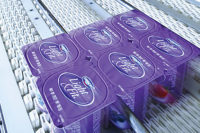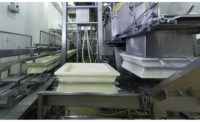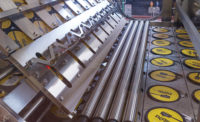In 2016, to accommodate its growth, Norwich, N.Y.-based Chobani invested $100 million to complete a 300,000-square-foot expansion to its manufacturing facility in Twin Falls, Idaho. Now totally 1,000,000 square feet, the plant (which opened in 2013) is said to be the largest yogurt manufacturing facility in the world. The company also has plants in South Edmeston, N.Y. and Dandenong, Australia (which supplies yogurt to that country).
I visited the plant in March. Before ever setting foot in the plant, I could see from the road that the scope and size of the facility was overwhelming. The expansive white building (with its large American flag painted on the far right side) dominates the skyline, even with the mountain view in the distance. The plant is surrounded by mostly open fields and grass, though Clif Bar & Co. is now a nearby neighbor.
As part of the expansion, the company added three production lines to manufacture Flip, its fastest growing yogurt platform; a new production line and a new bulk production line for foodservice opportunities to drive more growth in schools, hotels and airlines; and equipment for new adjacent categories like Chobani Drink. Even with all that, the company still has room to add more production lines when needed. The expansion also helped launch products to new international markets, including Mexico and Puerto Rico.
The company can produce any of its 107 SKUs out of this location, but of everything it makes, roughly 50% is Flip, 35% is Core and 15% is Drinks. This percentage does move around from week-to-week, according to Jason Blaisure, vice president of plant operations. All Drinks and Flips that Chobani sells are made at this facility. Read more about the company and its products in our company profile.
Inside the plant
Walking through the plant, a visitor sees a lot of white walls, making the size feel even larger. The long, expansive hallways with tall ceilings were intentionally designed in a way to feature light from above and feel inviting and inclusive, according to Michael Gonda, vice president of corporate communications and public affairs. One of the halls is painted with Chobani’s timeline, from its beginnings in 2005 to 2017, featuring company facts. And in a nearby hall, a giant Chobani raspberry Greek yogurt decal half way up the wall adds a splash of color.
The production and CIP rooms all have large viewing windows for visitors and staff to see what’s going on inside, from the quieter hallway environment. The plant was designed to help block out the noise from production areas, said Gonda.
Keeping with its inclusiveness, the company displays large TVs in various halls and in the breakrooms, which run what is called Cho-TV. The all-day programming includes employee interviews, from factory workers to corporate officers. The company has a staff of videographers, editors and designers who come up with all the content on a regular basis. The TV is for spreading the company culture and to communicate.
“It’s a great way for people to get to know a new person,” said Gonda. The same programming runs in the South Edmeston plant.
Currently, all of the office space, conference rooms and breakrooms are in attached trailers on one end of the plant. But the company recently got the green light from Founder and CEO Hamdi Ulukaya to move forward with additional construction dedicated entirely to employee space. It will invest $25 million to build approximately 50,000 square feet. The new space will include first-floor employee locker rooms and cafeteria space, second-floor offices and area for support staff (like IT and HR), and a third- floor R&D center. The new space will also have a training room and gym.
The company will break ground on that expansion by the end of this year and expects it will take about nine months to complete.
Making the Greek yogurt
Every day dozens of trucks, each containing 8,000 gallons of rBST-free milk, arrive at the plant from local dairies. The company gets all of its milk from Dairy Farmers of America and about 90% of the milk is sourced within a 50-mile radius of the plant within Magic Valley. The Magic Valley region makes up eight counties in south-central Idaho, including Twin Falls, Jerome, Blaine and Cassia.
Before any milk is unloaded the company tests it for antibiotics and temperature (it must be below 45 F). It can take about 2.5 hours to unload a truck, clean it and send it on its way.
Once tests are complete and quality is checked, the raw milk is pumped through a filter into 200,000-gallon tanks in the pasteurization room and kept at 45 degrees. The milk is stored up to 72 hours, but ideally it is used within 24 hours. Inside the tanks propellers circulate the milk to prevent the cream from separating.
The raw milk is then heated to 131 degrees and put through a separator that separates the cream from the 0.05% skim milk. The company saves some of the cream to use in its 2% and whole-milk Greek yogurts, Flips and Drinks, but most is sold to butter processors. The milk is then HTST pasteurized by heating it to an even higher temperature and filtered to remove any impurities.
The pasteurized milk is pumped to the maturation room where it begins its transformation into yogurt. The company mixes warm skim milk with its proprietary mother culture and probiotics. Once combined, the agitator is turned off and the mixture is left to mature for about 10 hours. As the pH goes down, the acid goes up, and the mixture turns into curds and whey.
Chobani uses three pounds of milk to make one cup of its Greek yogurt. The company’s straining process, which removes the excess liquid whey (separated into 1/3 curds and 2/3 whey), is said to result in a thicker, creamier yogurt. Once straining is complete, the yogurt is cooled to 60 degrees, which slows the fermentation process and prevents sour yogurt. The company sells 100% of its whey to local farmers who use it as nutrient supplement for the cows and as land-applied fertilizer.
The company’s process yields an average of 11 to 15 grams of protein per 5.3-ounce cup. In its Core line, the nonfat fruit-on-the-bottom strawberry contains 120 calories, 12 grams of protein and 15 grams of sugar.
The strained yogurt is pumped through stainless steel pipes to the second floor where it flows into filling machines. It’s here that variations of cream and/or fruit are added, which can produce more than 50 different yogurts. The company has four different domestic fruit suppliers. All have to meet Chobani’s non-GMO and ingredients guidelines.
Cups are filled with yogurt at a rate up to 40,000 per hour per line. When Dairy Foods visited, the company was making several different products at once, including Flip, Drink (the mango flavor), Tubes, Tot Pouches (which is a product specially designed for children older than six months), and several flavors of Core (like strawberry and blended coconut).
For Flip, all dry ingredients (nuts, fruit, chocolate, etc.) are sourced globally. Each is received individually and tested against quality standards. The ingredients are blended and added onto a shaking conveyor belt which maintains the proper blend of ingredients. The blended ingredients are individually proportioned and dropped into the “sidecar” of the Flip cups.
The company uses robotic machines to package the cups into cases and stack them on pallets. The pallets are moved to a conveyor belt that takes the yogurt into chill tunnels that cool the product below 45 F. Finally, the cases move to a cold warehouse, where they sit for several days, solidifying into thick Greek yogurt. Chobani’s cold warehouse is over 299,000 square feet.
From here, product will be shipped directly to customers (national grocery chains, drugstores, club and convenience stores) or to one of the other three distribution centers in Wilmington, Ill., Arlington, Ill., or Fort Worth, Texas. There is also a distribution center at the South Edmeston plant.
Keeping the yogurt safe
The plant is Safe Quality Foods Level 3-certified and has a 2,500 square-foot lab on site. The company checks the yogurt from production lines every hour to ensure its safety and quality. With each check comes all of the required micro testing (for bacteria, pathogens, etc.).
“In conjunction with that, we’re also doing our product quality testing,” said Blaisure. This includes texture, Brix, butterfat, organoleptic and shelf-life testing.
Before a product is released it has to clear all the tests mentioned above. It also has to rest for an additional amount of time which Chobani keeps proprietary. Because of its own internal quality control demands, the challenge for the company is making sure yogurt moves fast enough from production to packaging.
“Our product has an incredibly short internal shelf life, so from the moment that our yogurt completes fermentation to the time that it has to be in a cup, [the time] is very short,” said Blaisure. The time is measured in hours, not days.
“The most important thing is to have very solid preventative maintenance programs so that you can count on the equipment and operate efficiently,” said Blaisure. Production is planned 12 hours ahead of time, he said.
The equipment is washed on a continuous cycle (some every 24 hours, others have extended run approvals). It depends on each line and requirement. Blaisure said the vast majority of the lines are washed when an order is completed; most orders take less than 24 hours to fulfill.
The company uses a centralized CIP system. With cleaning taking place almost daily, Chobani needs to schedule all CIP in order to be able to stagger the cleanings. Cleaning effectiveness is determined with swab monitoring.
“We’ve invested in our sanitation quality team since 2013, which has helped us with not only our CIP verifications, but also our very extensive environmental monitoring program,” said Blaisure. “[With] dairy, it’s critically important that not just the equipment is clean, but that the air is clean, the walls, everything.”
As part of its quality control program, each production and CIP room has its own set of cleaning supplies which are organized by specific colors. For example, red is for raw product areas, yellow is for non-product, green is for allergen areas and white is for product contact.
Sustainability and communication
Last year the company hired Nate Shepley Streed as director of sustainability. He is working on a long-term plan to help meet the company’s sustainability goals. Currently, the company is undergoing a full energy audit, so its focus is on how to reduce electricity. Two practices are using motion sensors in rooms and changing to energy-saving LED light bulbs.
In 2015, Chobani was named Idaho Power’s “Top Energy Savings Company” for saving nearly 13 million kilowatt hours at the Twin Falls facility.
On the water side, the dairy processor is investigating new technologies for purification. Currently the company invests a lot of money into its reverse osmosis (RO) system so that it can remove a good deal of water from the whey stream. The goal is to reuse that water in the plant for its CIP systems.
“We use an RO system to treat the water, which is effective, but the challenge of that is you have 30% waste of the incoming water stream. The new technology will hopefully change that, so that it’s a zero-waste stream,” Blaisure said.
The company recycles all packaging waste that hasn’t touched product. But the challenge is what to do with packaging that’s been exposed to product, since recycling firms don’t want to touch that.
“It goes back to making sure your lines are running more efficiently so that they’re producing much less waste on the line,” Blaisure said. Chobani has decreased the pounds sent to landfill by approximately 20% since 2015.
In 2016, the company donated 259,699 cases of yogurt to local food banks and food pantries and fed community members in need.
Part of what helps the plant run efficiently is communication — from within and with its other plant.
Blaisure, who’s based in New York, oversees both the New York and Idaho locations. In 2015 he officially took over responsibility for the plant and rented a home nearby for a couple years. Last year, the company hired Scott Corsetti as vice president of operations for Twin Falls allowing Blaisure to spend more time at home.
Blaisure said there is a lot of communication between Twin Falls and South Edmeston. Every Tuesday and Thursday at 9 a.m. he gets on the phone with the operations teams from both plants for what is called the “Customer-First Call.” They review what’s being made where (to avoid redundancy), they talk about the distribution network, what are sales trends, any deviation from forecast, etc.
Training and its workforce
According to Blaisure, there is no defined career path for Chobani employees and that’s on purpose.
“We don’t try to create boxes for the employees. Anything that they’re interested in we encourage and get them back to the cross training, not within the department, but throughout the entire plant,” said Blaisure.
And throughout the organization, added Gonda. The company encourages employees to seize all opportunities, he said.
Equipment operators are cross-trained to run a variety of machines across the plant.
All employees go through extensive safety training when they’re first hired and the company also does monthly safety training. The safety team does some off-site training with a program called Safety Fest at the College of Southern Idaho. It also partnered with other companies to bring programs in to help with training in regards to equipment and allergens.
The company has an on-site physical trainer, something it started doing two years ago. If someone has a stress injury they are sent to work with that trainer. Blaisure said it’s been one of the most important changes made in terms of personal safety.
“[It] cut our incident rate in half. It’s been tremendous, the improvement,” he said. To also help reduce chance of injury, the workers do stretching sessions on the line at every shift change.
The ‘Chobani effect’
Chobani’s presence in Idaho has served as a catalyst for new jobs and continues to have a significant positive economic impact in the region, according to the company. Since its arrival, unemployment has reached record-low levels at 3%, down from 7% in 2015. Around a dozen major businesses from across the country have also moved to the region, such as Clif Bar (which moved in last year), Monsanto Wheat Technology Center, Fabri-Kal and Dow.
The company works closely with the community of Twin Falls to support local initiatives. Chobani has initiated a job training program in conjunction with the College of Southern Idaho. The Chobani Foundation, the company’s charitable arm, has supported several projects, including the Twin Falls Downtown Renaissance Project, Special Olympics Idaho, the Canyon Rim Classic Soccer Tournament, numerous hunger relief agencies and veterans service organizations.
Gonda, who is also based in New York, tries to visit the Twin Falls plant once a month.
“The community is really important and I can’t do that over the phone,” Gonda said. “Establishing relationships with our public officials, our dairy farmers, you come out here. I really enjoy doing it. It’s also extremely important to our founder that we have deep ties to our community.”
At-A-Glance
Chobani, Twin Falls, Idaho
- Interstate Milk Shippers plant 16-12. Enforcement rating of 99 (April 2017)
- Year plant opened: 2013
- Additions: 2016, added 300,000 square feet
- Size: 1,000,000+ square feet
- Acreage: 200+
- Employees: About 1,000
- Products made and formats: 5.3-ounce Core Greek yogurt (nonfat, low-fat, whole-milk), 5.3-ounce Flip (low-fat, whole-milk), Simply 100 (5.3-ounce), Tubes (2-ounce), Tots Pouches (3.5-ounce), Drink (10-ounce)
- Total processing capacity: 40 million pounds of milk per week
- Number of shifts: 11 shifts
- Storage silos: 8
- Number of filling lines/types: 15
- Warehouse size: 254,021 square feet of refrigerated space; 12 bays










